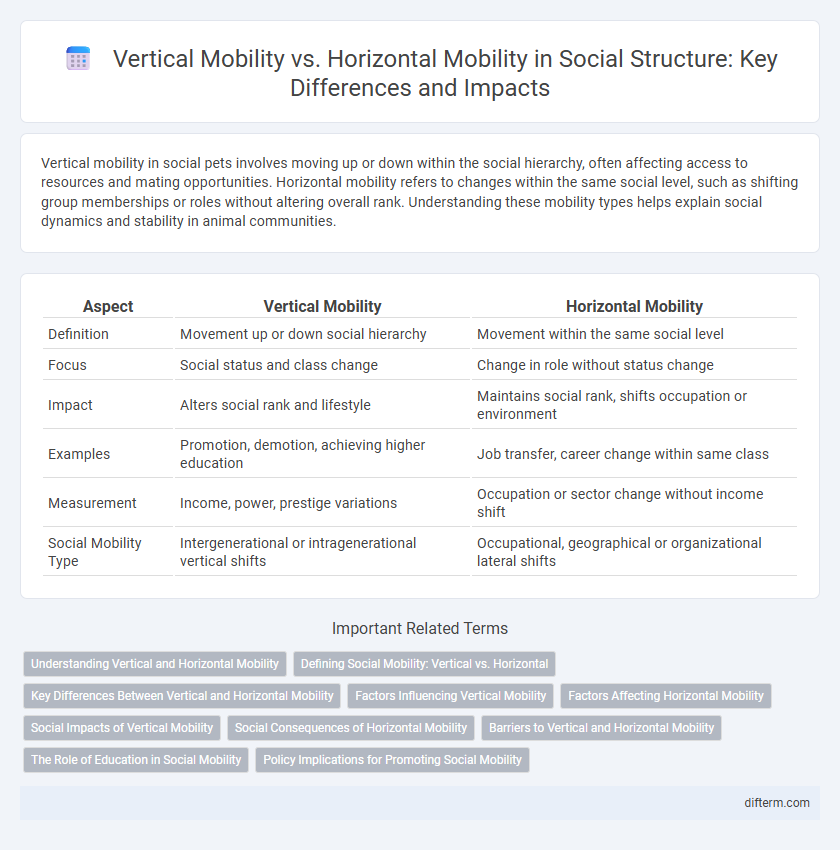Vertical mobility in social pets involves moving up or down within the social hierarchy, often affecting access to resources and mating opportunities. Horizontal mobility refers to changes within the same social level, such as shifting group memberships or roles without altering overall rank. Understanding these mobility types helps explain social dynamics and stability in animal communities.
Table of Comparison
| Aspect | Vertical Mobility | Horizontal Mobility |
|---|---|---|
| Definition | Movement up or down social hierarchy | Movement within the same social level |
| Focus | Social status and class change | Change in role without status change |
| Impact | Alters social rank and lifestyle | Maintains social rank, shifts occupation or environment |
| Examples | Promotion, demotion, achieving higher education | Job transfer, career change within same class |
| Measurement | Income, power, prestige variations | Occupation or sector change without income shift |
| Social Mobility Type | Intergenerational or intragenerational vertical shifts | Occupational, geographical or organizational lateral shifts |
Understanding Vertical and Horizontal Mobility
Vertical mobility refers to the movement of individuals or groups up or down the social hierarchy, often measured by changes in occupation, income, or social status. Horizontal mobility involves shifting within the same social level, such as changing jobs or locations without significant changes in social rank. Understanding these distinctions clarifies how people navigate social structures and the impact on their socioeconomic opportunities.
Defining Social Mobility: Vertical vs. Horizontal
Social mobility refers to the ability of individuals or groups to move within a social hierarchy, characterized by vertical mobility involving changes in social status or class, such as promotions or demotions. Horizontal mobility describes shifts within the same social level, including changing jobs or locations without altering social rank. Understanding the distinction between vertical and horizontal mobility is crucial for analyzing patterns of inequality and access to resources in society.
Key Differences Between Vertical and Horizontal Mobility
Vertical mobility involves moving up or down the social hierarchy, reflecting changes in socioeconomic status, such as promotions or demotions. Horizontal mobility refers to a change in position within the same social level, such as shifting jobs without altering income or prestige. Key differences include impact on social status, with vertical mobility affecting class standing while horizontal mobility maintains the existing social strata.
Factors Influencing Vertical Mobility
Education level significantly impacts vertical mobility by enhancing an individual's qualifications for higher-status jobs. Economic conditions and labor market demand shape opportunities for upward movement within social hierarchies. Social networks and family background also influence access to resources and support essential for achieving higher social positions.
Factors Affecting Horizontal Mobility
Horizontal mobility is primarily influenced by factors such as educational attainment, occupational changes within the same social class, and shifts in geographic location without altering social status. Social networks and cultural capital also play critical roles in facilitating or constraining horizontal movement, as they provide resources and opportunities within existing social strata. Economic conditions and institutional structures, including labor market dynamics, significantly impact the availability and direction of horizontal mobility opportunities.
Social Impacts of Vertical Mobility
Vertical mobility significantly influences social stratification by enabling individuals or groups to move up or down the socioeconomic hierarchy, impacting access to resources, education, and opportunities. This upward or downward movement often affects social networks, self-identity, and overall community dynamics. Consequently, vertical mobility can either reduce social inequality by promoting meritocratic progress or exacerbate social divides when upward mobility is limited.
Social Consequences of Horizontal Mobility
Horizontal mobility, the movement of individuals or groups within the same social stratum, often leads to changes in social networks without altering overall status or power. This type of mobility can foster social cohesion by maintaining stability within communities while allowing for diversification of roles and experiences. However, it may also result in limited opportunities for economic advancement, perpetuating existing inequalities despite changes in occupational or residential positions.
Barriers to Vertical and Horizontal Mobility
Barriers to vertical mobility include limited access to education, economic inequality, and social networks that reinforce class divisions, restricting individuals from advancing to higher socioeconomic positions. Horizontal mobility faces obstacles such as rigid occupational structures, cultural norms, and industry-specific skill mismatches that prevent lateral career changes within the same social stratum. Both types of mobility are further constrained by systemic discrimination based on race, gender, and socioeconomic background, perpetuating cycles of social stratification.
The Role of Education in Social Mobility
Education significantly influences vertical mobility by providing individuals with skills and qualifications that enable upward movement in social hierarchies. Horizontal mobility often occurs when education leads to career changes within the same social strata, allowing individuals to shift roles without altering their social class. Accessibility and quality of education are critical factors that determine the extent to which social mobility can be achieved.
Policy Implications for Promoting Social Mobility
Effective policy measures targeting social mobility emphasize expanding access to quality education and job training programs, which facilitate vertical mobility by enabling individuals to achieve higher socioeconomic status. Encouraging inclusive labor markets and anti-discrimination laws supports horizontal mobility by allowing people to move across different occupations without losing social standing. Investments in early childhood development and social safety nets are key strategies to reduce barriers and promote equitable opportunities across both vertical and horizontal mobility dimensions.
vertical mobility vs horizontal mobility Infographic

 difterm.com
difterm.com